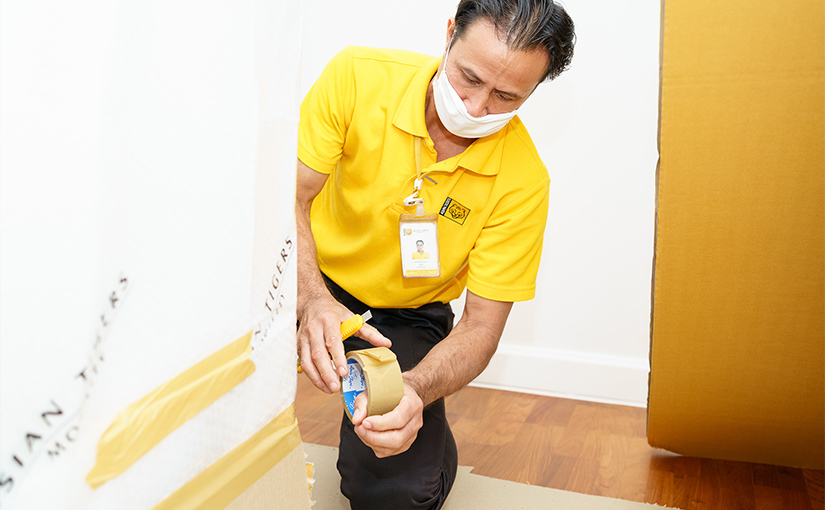How to Pack Paintings for Moving?
Relocation is quite a stressful process, especially with valuable or sentimental things such as paintings. Proper packing of your paintings is very cardinal to ensure their arrival without damage in your new home. Properly packing your artwork can make all the difference when moving across the country or across the neighborhood. In this article, we will teach you how to pack paintings for moving—materials and packing techniques.
1. Collect the Right Packing Materials
So, to learn how to pack paintings for moving properly, foremost, you have to collect the right materials. The right supplies make sure that your art doesn’t get scratched or dented during transit. Here’s a checklist of what you’ll need:
- Acid-Free Paper: It is going to protect the surface of your painting from scratching other items or materials applied during packing, and at the same time, add a space layer between those and the canvas.
- Bubble Wrap: Something that is going to be cushioning your painting during travels and absorbing the shocks.
- Packing tape: Something to tape the bubble wrap and other items you hold in place.
- Corner Guards: Corner guards can be made with the help of cardboard or foam, and those can help protect the frame corners, which are highly damaged during the movement.
- Cardboard: Cardboards or foam boards to create a protective layer around the paint so that it doesn’t bend.
- Rigid Box: The provided extra space to introduce more padding, but should not be so big that it lets the painting inside to get more movement.
- Plastic Wrap: To protect the painting from moisture and dust.
Pro Tip
For very expensive or extra-large pieces, you actually might want to invest in a special art shipping crate or box.
2. Prepare the Painting
Before you pack, do as follows: Lightly dust the surface of the painting with a soft dry cloth to get rid of loose particles. If it is not an acrylic or oil painting or framed behind glass please make sure the glass is clean and dry.
Protecting the Surface
- Step 1: Put the painting face down on a clean, flat surface.
- Step 2: Place a sheet of acid-free paper over the back of the painting to avoid dust, dirt, or scratches on the surface when moving.
- Step 3: In case the painting is unframed, the entire canvas should be wrapped in acid-free paper before proceeding with the next step.
Pro Tip
Do not use newspapers or similar papers which might ink or chemicals from the paper onto the painting.
3. Wrapping the Painting in Bubble Wrap
Bubble wrap is the first protective layer for your painting, which protects it from physical damage. It cushions your art and absorbs any bump or shock on the way.
Wrapping Process
- Step 1: Put a sheet of the bubble wrap below, large enough to cover the painting completely. Put the bubbles outward so that they are able to take up any bumps and shocks.
- Step 2: Put the painting down on the bubble wrap, face down, and then cover the back with the wrap.
- Step 3: Tape the bubble wrap using packing tape; ensure that all sides are protected and that it’s snug, but not too tight, which can cause damage to the painting.
Pro Tip
In case your painting needs to be given extra care in terms of protection, consider double-wrapping with bubble wrap.
4. Add Corner Protectors
Corners are the easiest parts of a painting to get damaged during a move. Putting corner protectors will keep the frame from damage or chipping.
Attaching Corner Protectors
– Step 1: Apply corner protectors to each corner of the painting. These can be bought or made out of cardboard or foam.
– Step 2: Ensure that the protectors fit well but are not too tight that can press harshly on the frame edges; they should just cover the corner without pressing too hard on the frame.
Pro Tip
If you don’t get the corner protectors available in the stores, instantly get some cardboard, cut them into little squares, then fold the squares into triangles, holding it with tape.
5. Cardboard or Foam Board Protective Layer Creation
Now that your painting is wrapped and the corners are taken care of, now it’s time to add a rigid layer to prevent any bend or warp during the move.
Adding the Protective Layer
- Step 1: Cut two pieces of cardboard or foam board to the size of the painting.
- Step 2: Place one piece on the front and one on the back of the wrapped painting.
- Step 3: Secure these boards in place with packing tape so that these do not move around and form a solid layer of protection.
Pro Tip
Now, remember that in the event you’re shipping multiple goods of art in one go, make sure that each piece of canvas art is separated using an extra piece of foam board or cardboard in the middle so they do not rub against one another.
6. Placing the Painting into a Sturdy Moving Box
The final step in how to pack paintings for moving becomes to box up the protected painting inside a sturdy moving box that allows room inside for a slight cushioning between the interior walls of the box and over the top of the frame, without letting the painting move around in the box.
Boxing the Painting
- Step 1: Create a cushioning layer by lining the bottom of the box with crumpled packing paper or foam peanuts.
- Step 2: Insert the painting in the box, making sure it has a good fit.
- Step 3: Fill the remaining space in the box with more packing paper or peanuts, making sure that the painting doesn’t have any room in the box to shift.
- Step 4: Close the box with packing tape, and make certain it is well-sealed, marking it “Fragile” and “This Side Up.” This will indicate just what manner it should be handled in.
Pro Tip
You can even tape a “Handle with Care” label on the box for an added precaution to ensure that movers treat it with the kind of caution it warrants.
7. Consider Professional Movers
Especially in the case of highly valuable paintings or those of sentimental value, or even very large paintings, it may be right to engage the services of professional movers to move art. They are better trained and equipped with materials to handle your packed artwork safely.
Advantages of Hiring Professional Movers
Experience: These professional movers expand an experience in packing delicate things and all sorts of artwork.
Insurance: Many moving firms offer insurance options where the damage on the artwork is covered, bestowing peace of mind.
Specialized Equipment: These professional movers have access to some special crates and packing materials that provide extra care for your paintings.
Pro Tip
If you decide to hire professional movers, be sure to talk about the value and special requirements for packing your artwork ahead of time.
Conclusion
To sum it all up, knowing how to pack paintings for moving is crucial to anybody interested in protecting their art from potential perils on the move. By having the right materials and being very keen on the details, you can rest assured that your paintings will make it to the new place in perfect condition. Everything from procuring proper supplies for packing to wrapping the paintings and placing them in boxes needs to be done perfectly, as every stage in the art moving process is extremely critical for the safety of your valuable art. Following these tips, even when moving your paintings on your own or with the aid of professional packers, will ensure the works of art are transported untouched, safely, and securely.
If you’d like to discover the latest information about the moving and relocation world, please also check other industry news from Asian Tigers Group.
Your trusted moving support is only a few clicks away from your hand. Contact the Asian Tigers office near your origin or destination for your next move. You can also check our Frequently Asked Questions resource, AI-powered by Tiger Move Bot.










